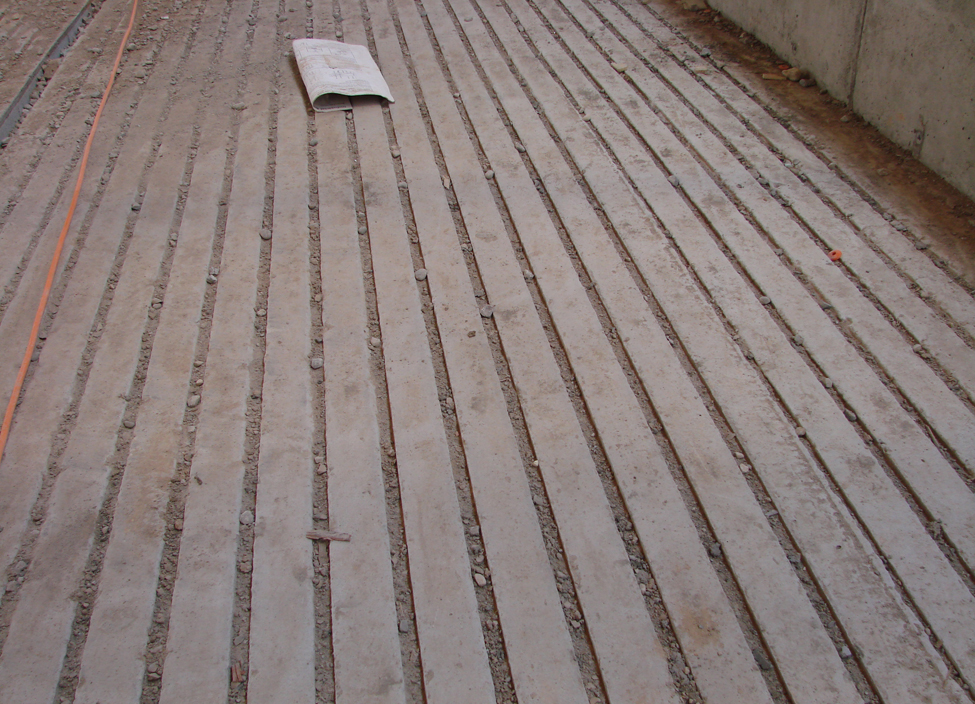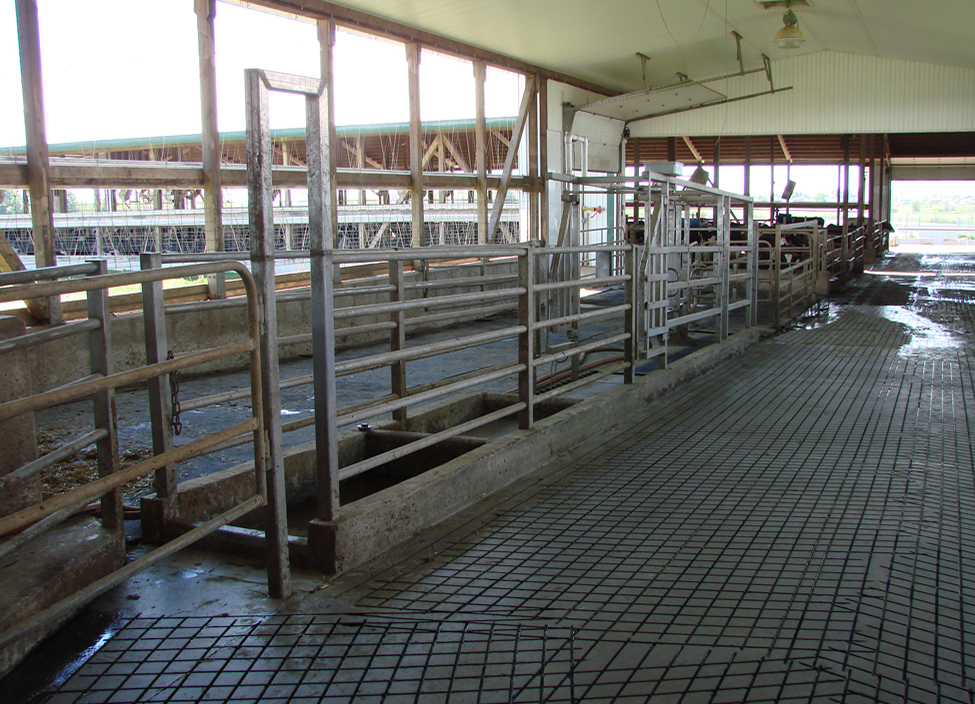Floor finish options for dairy free-stall housing
Learn about creating textured, yet smooth floor finishes for dairy cow barns. This technical information is for Ontario dairy farmers.
ISSN 1198-712X, Published July 2016
Introduction
In a dairy barn, floor surfaces must have a finish with enough texture to provide traction for the cow as she walks, yet be smooth enough to clean properly. In some cases, floors are so smooth that cows slip and injure themselves, and in other cases, the floors are so rough that cows develop feet and leg problems. There is a fine balance between traction and cleanability.
Alley floors must be strong and durable to resist manure acids and repeated cleaning. Start by using a minimum of 25 MPa concrete with 6% air entrainment. Air entrainment is a concrete additive that makes the concrete more durable.
Floor finishes
A good floor finish combines surface texture and grooves to provide traction. There are two ways of producing this combination: finish the concrete and form grooves in the surface while it is still wet or cut grooves in the floor after it has cured.
Wet finishes
Textured finish - A textured finish can be produced with an expanded metal roller to imprint the surface (Figure 1). This is referred to as a "jitterbug" or "rollerbug."

When concrete is first poured and levelled with a bull-float, it is glossy. It dries to a matte finish before hardening. When you see the matte finish, tap your fingers on the concrete. If you leave fingerprints and your fingers stay dry, it is the right time to use the roller to produce a textured surface.
Broom finish - A stiff broom can be used to produce a "broom" finish by brushing the surface of the concrete while it is moist.
Floor grooving to reduce slippage
Cows will still slip, even on a floor with a good textured finish. Grooving the floor provides edges for the cow to catch her hooves on to keep her from slipping too far and falling. There is some debate on what is the best groove pattern.
Longitudinal grooves - One approach is to make grooves parallel to the feed manager (Figure 2) 2 cm wide x 1.25 cm deep, spaced 8.25 cm on centre (3/4 in. wide x 1/2 in. deep, spaced 31/4 in. on centre).

Diamond pattern - The other approach is to make the grooves in a diagonal pattern (Figure 3), 1.25 cm wide x 1-1.25 cm deep, spaced 10-15 cm apart (1 in. wide x 3/8-1/2 in. deep, spaced 4-6 in. apart).
Longitudinal grooves are easy to form, but in areas where cows must make sharp turns, such as crossovers, add grooves at an angle to create a diamond pattern to provide extra traction for the cow when she turns.

Wet grooving - Forming the grooves in wet concrete is an art. If they are formed when the concrete is too wet, the grooves will not hold their shape. If the concrete becomes too dry, it will be difficult to form the grooves, and the surface finish may be harmed. Be careful to maintain a flat surface when grooving. Grooving when the concrete is wet displaces concrete, and it is important that the surface does not become curved between grooves.
It may be necessary to remove the initial roughness of freshly poured concrete floors that have been wet-grooved. One method is to drag several concrete blocks behind an all-terrain vehicle until the sharp edges are worn off the concrete. Another method is to use a steel scraper on the surface. Either method will remove sharp edges and help age the floor surface, reducing the chance of causing sore feet.
Cutting grooves - It is easier to obtain more consistent results by finishing the concrete with a broom finish and letting it harden for at least 14 days. After the concrete has cured, cut the grooves into the floor.
Surface treatment
Cows may experience problems if they are put on concrete before it has finished curing. High surface alkalinity may irritate the skin of the feet, causing pain and possibly making cattle more susceptible to foot infection. To avoid this problem, allow the concrete to cure properly for 28 days. After this time, the concrete is almost totally cured. Hydration, the chemical reaction that takes place during curing, will have slowed down. Wash off the concrete. The cattle can then be put on it with little or no effect on their feet. If cows have to be put on the concrete before 28 days, allow it to cure for at least 7 days, then wash it with a solution of 40 parts water to 1 part muriatic acid. The acid will neutralize the alkalinity of the floor. Wash the floor thoroughly, with water, to remove the residue.
Some producers have found that spraying the concrete surface with a 50:50 mixture of boiled linseed oil and diesel fuel helps seal the surface and prevent foot injuries.
Maintaining the floor surface
Manure removal equipment, such as alley scrapers, will polish the alley floors. In a free-stall barn, use a rubber tire scraper or add a piece of durable rubber to the bottom of the scraper blade to protect the floor finish.
Treating worn floors
Concrete floors can become too smooth from repeated scraping for manure removal. Traction on slippery floors can be improved by cutting grooves into the floor in a diagonal pattern similar to a new floor. Another method is to grind or mill small grooves into the entire surface to improve traction (Figure 4).

Sand bedding and its effect on flooring
Cows "kick" sand out of the stalls into the alleyways when getting up and down in free stalls bedded with sand. The sand that ends up in the alley improves cow traction on the floor. An alley that does not have stalls exiting onto it won't have the same amount of sand on them, making them more slippery than other alleys in the same barn that have more sand on them.
Rubber surfaces for flooring
Rubber or similar products are increasingly being used on alley floors to provide a softer surface than concrete for the cow to stand on. Cows show a definite preference for standing or walking on the rubber surfaces. It is important to use a material that is durable but is not so hard that it is slippery. It is also important to have the material fastened down properly so that manure removal equipment will not catch on it.
Hooves will not wear the same on rubber floors as on concrete floors. Cows may require more frequent foot trimming.
Hoof management
It is important to consider the condition of the cows' hooves before they are moved to a new barn. Do not trim cows' feet before moving them to a facility with new concrete. Their feet will be too tender, and injuries will occur. If feet need trimming, make sure there is adequate time for them to toughen up before moving them to the new barn.
Summary
Floor finishes are important for cow comfort and safe movement. Alley floors must be strong and durable, while providing good traction for cows. Surface texture and grooving can be used on concrete to provide the traction necessary to keep cows from slipping and injuring themselves. To improve traction, groove or mill the surfaces of floors that are too slippery from repeated cleaning. Make sure that cows can move confidently on all floors.
Resources
Agri-Trac™. Woodstock, ON.
Grandview Concrete Grooving. Arthur, ON.
Bickert, W.G., et al. 2000. Dairy Freestall Housing and Equipment. 7th edition. MWPS-7. Midwest Plan Service. Iowa State University. Ames, IA.
Cook, N. 2012. Managing Floor Grooves. The Dairyland Initiative. University of Wisconsin. Madison, WI.
This factsheet was written by Harold K. House, P.Eng., Engineer, Dairy and Beef Housing and Equipment, Clinton, OMAFRA (retired).